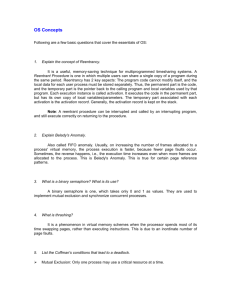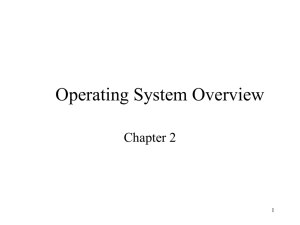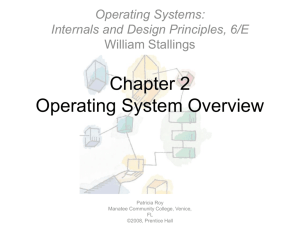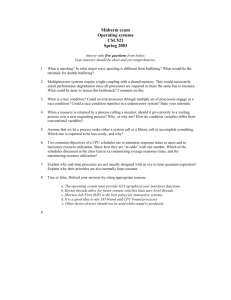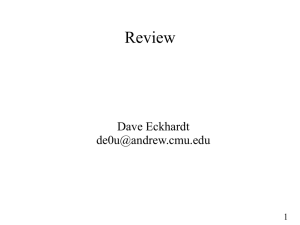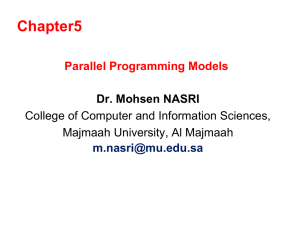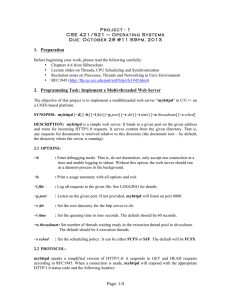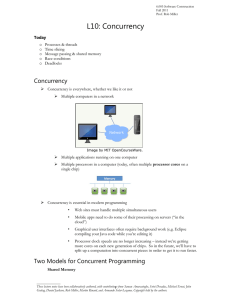OPERATING SYSTEM ENGINEERING NOTES 2 11. When is a
advertisement
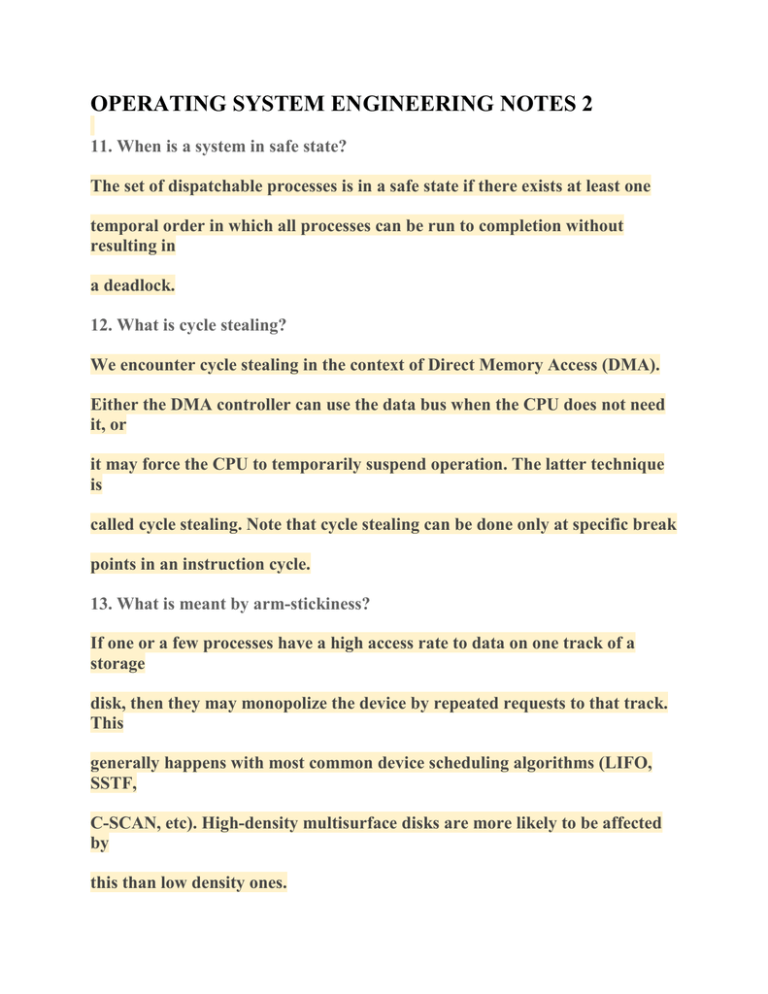
OPERATING SYSTEM ENGINEERING NOTES 2 11. When is a system in safe state? The set of dispatchable processes is in a safe state if there exists at least one temporal order in which all processes can be run to completion without resulting in a deadlock. 12. What is cycle stealing? We encounter cycle stealing in the context of Direct Memory Access (DMA). Either the DMA controller can use the data bus when the CPU does not need it, or it may force the CPU to temporarily suspend operation. The latter technique is called cycle stealing. Note that cycle stealing can be done only at specific break points in an instruction cycle. 13. What is meant by arm-stickiness? If one or a few processes have a high access rate to data on one track of a storage disk, then they may monopolize the device by repeated requests to that track. This generally happens with most common device scheduling algorithms (LIFO, SSTF, C-SCAN, etc). High-density multisurface disks are more likely to be affected by this than low density ones. 14. What are the stipulations of C2 level security? C2 level security provides for: 1. Discretionary Access Control 2. Identification and Authentication 3. Auditing 4. Resource reuse 15. What is busy waiting? The repeated execution of a loop of code while waiting for an event to occur is called busy-waiting. The CPU is not engaged in any real productive activity during this period, and the process does not progress toward completion. 16. Explain the popular multiprocessor thread-scheduling strategies. 1. Load Sharing: Processes are not assigned to a particular processor. A global queue of threads is maintained. Each processor, when idle, selects a thread from this queue. Note that load balancing refers to a scheme where work is allocated to processors on a more permanent basis. 2. Gang Scheduling: A set of related threads is scheduled to run on a set of processors at the same time, on a 1-to-1 basis. Closely related threads / processes may be scheduled this way to reduce synchronization blocking, and minimize process switching. Group scheduling predated this strategy. 3. Dedicated processor assignment: Provides implicit scheduling defined by assignment of threads to processors. For the duration of program execution, each program is allocated a set of processors equal in number to the number of threads in the program. Processors are chosen from the available pool. 4. Dynamic scheduling: The number of thread in a program can be altered during the course of execution. 17. When does the condition 'rendezvous' arise? In message passing, it is the condition in which, both, the sender and receiver are blocked until the message is delivered. 18. What is a trap and trapdoor? Trapdoor is a secret undocumented entry point into a program used to grant access without normal methods of access authentication. A trap is a software interrupt, usually the result of an error condition. 19. What are local and global page replacements? Local replacement means that an incoming page is brought in only to the relevant process address space. Global replacement policy allows any page frame from any process to be replaced. The latter is applicable to variable partitions model only. 20. Define latency, transfer and seek time with respect to disk I/O. Seek time is the time required to move the disk arm to the required track. Rotational delay or latency is the time it takes for the beginning of the required sector to reach the head. Sum of seek time (if any) and latency is the access time. Time taken to actually transfer a span of data is transfer time. 21. Describe the Buddy system of memory allocation. Free memory is maintained in linked lists, each of equal sized blocks. Any such block is of size 2^k. When some memory is required by a process, the block size of next higher order is chosen, and broken into two. Note that the two such pieces differ in address only in their kth bit. Such pieces are called buddies. When any used block is freed, the OS checks to see if its buddy is also free. If so, it is rejoined, and put into the original free-block linked-list. 22. What is time-stamping? It is a technique proposed by Lamport, used to order events in a distributed system without the use of clocks. This scheme is intended to order events consisting of the transmission of messages. Each system 'i' in the network maintains a counter Ci. Every time a system transmits a message, it increments its counter by 1 and attaches the time-stamp Ti to the message. When a message is received, the receiving system 'j' sets its counter Cj to 1 more than the maximum of its current value and the incoming time-stamp Ti. At each site, the ordering of messages is determined by the following rules: For messages x from site i and y from site j, x precedes y if one of the following conditions holds....(a) if Ti<Tj or (b) if Ti=Tj and i<j. 23. How are the wait/signal operations for monitor different from those for semaphores? If a process in a monitor signal and no task is waiting on the condition variable, the signal is lost. So this allows easier program design. Whereas in semaphores, every operation affects the value of the semaphore, so the wait and signal operations should be perfectly balanced in the program. 24. In the context of memory management, what are placement and replacement algorithms? Placement algorithms determine where in available real-memory to load a program. Common methods are first-fit, next-fit, best-fit. Replacement algorithms are used when memory is full, and one process (or part of a process) needs to be swapped out to accommodate a new program. The replacement algorithm determines which are the partitions to be swapped out. 25. In loading programs into memory, what is the difference between loadtime dynamic linking and run-time dynamic linking? For load-time dynamic linking: Load module to be loaded is read into memory. Any reference to a target external module causes that module to be loaded and the references are updated to a relative address from the start base address of the application module. With run-time dynamic loading: Some of the linking is postponed until actual reference during execution. Then the correct module is loaded and linked. 26. What are demand-paging and pre-paging? With demand paging, a page is brought into memory only when a location on that page is actually referenced during execution. With pre-paging, pages other than the one demanded by a page fault are brought in. The selection of such pages is done based on common access patterns, especially for secondary memory devices. 27. Paging a memory management function, while multiprogramming a processor management function, are the two interdependent? Yes. 28. What is page cannibalizing? Page swapping or page replacements are called page cannibalizing. 29. What has triggered the need for multitasking in PCs? 1. Increased speed and memory capacity of microprocessors together with the support fir virtual memory and 2. Growth of client server computing 30. What are the four layers that Windows NT have in order to achieve independence? 1. Hardware abstraction layer 2. Kernel 3. Subsystems 4. System Services. 31. What is SMP? To achieve maximum efficiency and reliability a mode of operation known as symmetric multiprocessing is used. In essence, with SMP any process or threads can be assigned to any processor. 32. What are the key object oriented concepts used by Windows NT? Encapsulation, Object class and instance. 33. Is Windows NT a full blown object oriented operating system? Give reasons. No Windows NT is not so, because its not implemented in object oriented language and the data structures reside within one executive component and are not represented as objects and it does not support object oriented capabilities. 34. What is a drawback of MVT? It does not have the features like 1. ability to support multiple processors 2. virtual storage 3. source level debugging 35. What is process spawning? When the OS at the explicit request of another process creates a process, this action is called process spawning. 36. How many jobs can be run concurrently on MVT? 15 jobs. 37. List out some reasons for process termination. 1. Normal completion 2. Time limit exceeded 3. Memory unavailable 4. Bounds violation 5. Protection error 6. Arithmetic error 7. Time overrun 8. I/O failure 9. Invalid instruction 10. Privileged instruction 11. Data misuse 12. Operator or OS intervention 13. Parent termination. 38. What are the reasons for process suspension? 1. swapping 2. interactive user request 3. timing 4. parent process request 39. What is process migration? It is the transfer of sufficient amount of the state of process from one machine to the target machine. 40. What is mutant? In Windows NT a mutant provides kernel mode or user mode mutual exclusion with the notion of ownership. 41. What is an idle thread? The special thread a dispatcher will execute when no ready thread is found. 42. What is FtDisk? It is a fault tolerance disk driver for Windows NT. 43. What are the possible threads a thread can have? 1. Ready 2. Standby 3. Running 4. Waiting 5. Transition 6. Terminated 44. What are rings in Windows NT? Windows NT uses protection mechanism called rings provides by the process to implement separation between the user mode and kernel mode. 45. What is Executive in Windows NT? In Windows NT, executive refers to the operating system code that runs in kernel mode. 46. What are the sub-components of I/O manager in Windows NT? 1. Network redirector/ Server 2. Cache manager. 3. File systems 4. Network driver 5. Device driver 47. What are DDks? Name an operating system that includes this feature. DDks are device driver kits, which are equivalent to SDKs for writing device drivers. Windows NT includes DDks. 48. What level of security does Windows NT meets? C2 level security.
